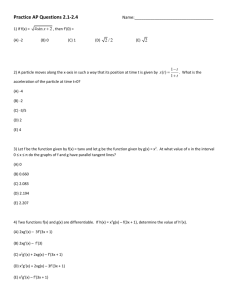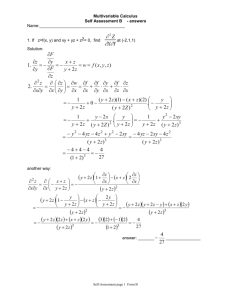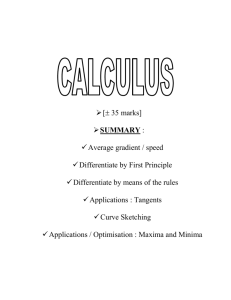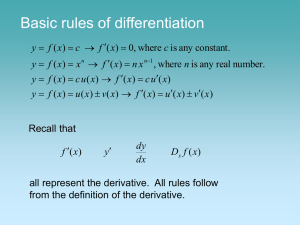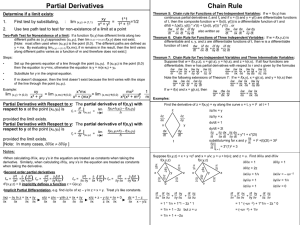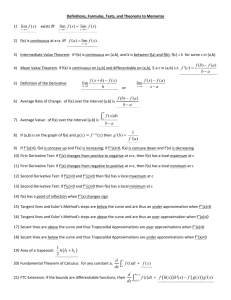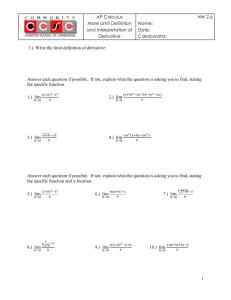rate of change
advertisement
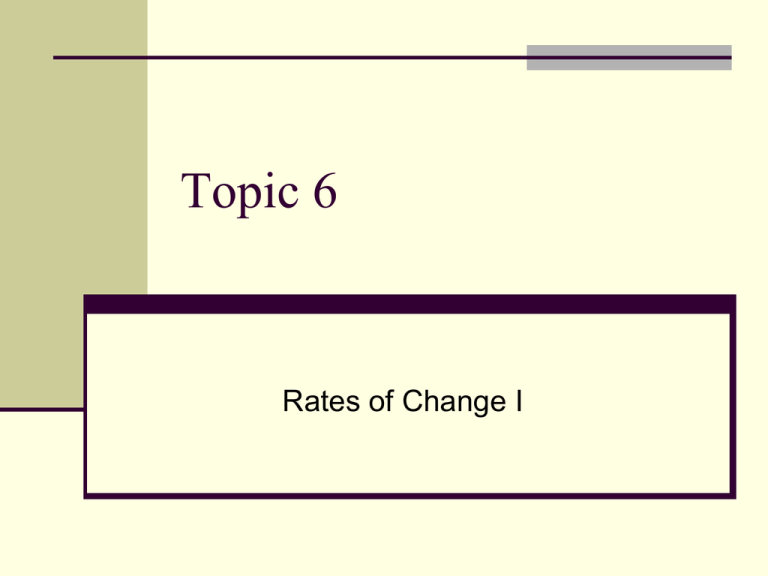
Topic 6 Rates of Change I Topic 6: New Q Maths Chapter 6.1 - 6.4, 6.7 Rates of Change I Chapter 8.2 concept of the rate of change calculation of average rates of change in both practical and purely mathematical situations interpretation of the average rate of change as the gradient of the secant intuitive understanding of a limit (N.B. – Calculations using limit theorems are not required) definition of the derivative of a function at a point derivative of simple algebraic functions from first principles Model : A cyclist travels 315 km in 9 hours. Express this in m/sec 315 km in 9 hours = 35 km in 1 hour 35 Km m 1Hr s = 9.72 m/sec (2dp) Read e.g. 3 Page 187 EXAMPLE 3: page 187 Volume (L) 5 12 15 20 25 Mass (Kg) 4.1 9.3 12 15.7 19.75 Kg/L EXAMPLE 3: page 187 Volume (L) 5 12 15 20 25 Mass (Kg) 4.1 9.3 12 15.7 19.75 Kg/L 0.82 0.78 0.80 0.79 0.79 Within experimental error, these variables are related by a fixed rate (≈ 0.79 Kg/L) Calculator Steps for Linear Regression TI – 83 (Enter data via Stat – Edit) 2nd Stat Plot Turn plot 1 on Choose scatter plot X list: L1 Y list: L2 Set window Graph TI – 89 (Enter data via APPS – option 6 – option 1). You may need to set up a variable if you’ve never used this function before. F2 (plot setup) F1 (define) Plot type → scatter x: C1 y: C2 Frequency: no Enter to save You’ll return to this screen (ESC) Set window Add a Regression Line TI – 83 Turn on DiagnosticOn (via catalog) Stat – Calc 4: LinReg LinReg L1, L2, Y1 Enter (examine stats) Graph TI – 89 F5: calc Calc type → 5: LinReg x: C1 y: C2 Store regEQ → y1 Freq → no Enter to save Graph Exercise NewQ P 188 Exercise 6.1 Rates of Change The rate of change of a second quantity w.r.t. a first quantity is the quotient of their differences: changein quantity2 Rate of change changein quantity1 y x y2 y1 x2 x1 Read e.g. 4 Page 190 (Do on GC) N.B. If the rate of change is constant, the graph will be a straight line. Consider the following situation: A car travels from Bundaberg to Miriamvale (100 km) at 50 km/h. How fast must he travel coming home to average 100 km/h for the entire trip? N.B. Average speed = total distance total time Consider the following situation: A car travels from Bundaberg to Miriamvale (100 km) at 80 km/h. How fast must he travel coming home to average 100 km/h for the entire trip? Exercise NewQ P 193 Exercise 6.2 Use CBR to emulate motion graphs Use your GC to find the rate of change of y = 2 + 4x – 0.25x2 from x = 3 to x = 5 Draw graph Find VALUES Rate of change = 4/2 = 2 y (5 , 15.75) 15 (3 , 11.75) 10 5 x 0 -2 -1 0 1 2 3 4 5 6 7 Exercise NewQ P 198 Exercise 6.3 No. 1, 2, 4, 6(a&b), 7 Exercise NewQ P 204, 212 Exercise 6.4 no. 2, 5, 6 & 7 6.6 no. 1-3, 6, 9 y = x2 + 2 y = x3 –x2 -4x + 4 Finding Tangents Differentiation 1: (11B) An algebraic approach Differentiation by First Principles -Tangent applet Let P[ x, f(x) ] be a point on the curve y = f(x) and let Q be a neighbouring point a distance of h further along the x-axis from point P. Q [ x+h, f(x+h) ] Q [ x+h, f(x+h) ] f(x+h) – f(x) P[x, f(x)] h x+h - x Let P[ x, f(x) ] and let Q[ x+h, f(x+h) ] y y2 y1 m pq x x2 x1 Gradient of tangent = lim h0 f(x+h) – f(x) f (x h) h f ( x) xh x Q[x+h,f(x+h)] f(x+h) – f(x) P(x,f(x)) x+h - x First Principles Model Find the gradient of the tangent to f(x)= x2 at the point where x = 2 Let P be the point (2, 4) and let Q be the point [(2+h), f(2+h)] f ( x h) f ( x ) Gradient PQ lim h 0 h (2 h) 2 4 lim h 0 h 4 4h h 2 4 lim h 0 h 4h h 2 lim h 0 h h(4 h) lim h 0 h lim 4 h h 0 4 y 15 Q 10 5 P x 0 -4 -3 -2 -1 0 1 2 3 4 Scootle: First Principles Models Use first principles to find the gradient of the curve (a) y = 2x2 – 13x + 15 at x=5 (b) y = x2 + 3x - 8 at any point Differential Graphing Tool Exercise NewQ P 262 Exercise 8.2 Differentiation 1: (11B) 2-5 -Tangent applet - 3 derivative puzzles Q: Differential Functions (11B) Q: Differentiate Polynomials (11B)


